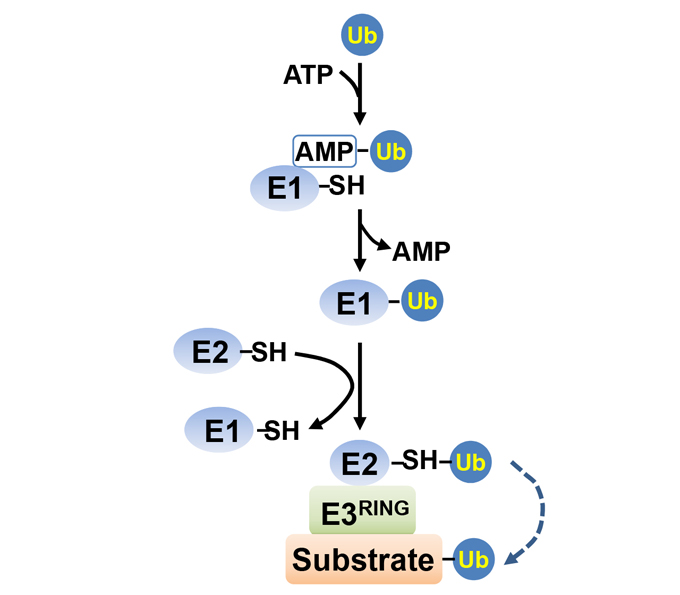

植物蛋白的体外泛素化检测方法
收稿日期: 2019-08-12
录用日期: 2019-10-31
网络出版日期: 2019-10-31
基金资助
国家自然科学基金(No.31200907);山东省自然科学基金(No.ZR2014CL1009);植物基因组学国家重点实验室开放课题(No.2016A0219-14)
In Vitro Ubiquitination Assay for Plant Proteins
Received date: 2019-08-12
Accepted date: 2019-10-31
Online published: 2019-10-31
泛素激活酶(E1)、泛素耦联酶(E2)和泛素连接酶(E3)是蛋白质泛素化修饰的关键酶。在真核基因组上有大量基因编码这些泛素化相关的酶类或蛋白。检测这些泛素化修饰酶及其底物蛋白的生化特性和特异性是分析其生物学功能的重要内容。该文提供了一种简便快速检测体外泛素化反应的方法, 不仅可通过检测对DTT敏感的硫酯键的形成来判断E2的活性、检测E3的体外泛素化活性, 而且可以检测E2-E3和E3-底物的特异性。所用蛋白主要来源于拟南芥(Arabidopsis thaliana), 包括分属于绝大多数E2亚家族的成员, 可用于不同RING类型E3的活性检测。该方法不仅可以采用多种E2进行E3活性分析, 而且可以分析不同组合的E2-RING E3、RING E3-底物的泛素化活性等, 亦可应用于真核生物蛋白质尤其是植物蛋白的体外泛素化活性分析。

赵庆臻 , 刘利静 , 谢旗 , 于菲菲 . 植物蛋白的体外泛素化检测方法[J]. 植物学报, 2019 , 54(6) : 764 -772 . DOI: 10.11983/CBB19152
Ubiquitin activating enzyme (E1), ubiquitin conjugating enzyme (E2) and ubiquitin protein ligase (E3) are the key enzymes of ubiquitin modification of substrate proteins. There are large amounts of genes encoding these ubiquitination enzymes in all eukaryotic genomes. Analyzing the biochemical characteristics and specificity of these enzymes and their substrate proteins is important for their functional study. Here we describe a simple and fast method for in vitro ubiquitination assay. In the presence of E1 and ubiquitin, E2 activity can be determined by detecting the DTT-sensitive thio-ester formation. The E3 activity of a putative protein as well as the E2-E3 or E3-substrate specificities can also be explored by in vitro ubiquitination assay. This system is mainiy based on proteins from Arabidopsis, which includes most varieties of Arabidopsis E2 proteins that are tested with several RING-finger type E3 ligases. This system facilitate not only the exploration of E3 activity in combination with various Arabidopsis E2 members but also the study of E2-RING E3 and RING E3-substrate specificities. This system is suitable for the ubiquitination assays of eukaryotic proteins, especially for plant proteins.

| [1] | 张祥云, 赵思语, 温潇, 王宁, 郭彦, 赵庆臻 ( 2018). 小麦TaUBC基因泛素结合酶活性分析. 聊城大学学报(自然科学版) 31, 79-85. |
| [2] | Bachmair A, Novatchkova M, Potuschak T, Eisenhaber F ( 2001). Ubiquitylation in plants: a post-genomic look at a post-translational modification. Trends Plant Sci 6, 463-470. |
| [3] | Callis J ( 2014). The ubiquitination machinery of the ubiquitin system. Arabidopsis Book 12, e0174. |
| [4] | Hua ZH, Vierstra RD ( 2011). The cullin-RING ubipuitinprotein ligases. Annu Rev Plant Biol 62, 299-334. |
| [5] | Kraft E, Stone SL, Ma LG, Su N, Gao Y, Lau OS, Deng XW, Callis J ( 2005). Genome analysis and functional characterization of the E2 and RING-type E3 ligase ubiquitination enzymes of Arabidopsis. Plant Physiol 139, 1597-1611. |
| [6] | Michelle C, Vourc'h P, Mignon L, Andres CR ( 2009). What was the set of ubiquitin and ubiquitin-like conjugating enzymes in the eukaryote common ancestor? J Mol Evol 68, 616-628. |
| [7] | Miricescu A, Goslin K, Graciet E ( 2018). Ubiquitylation in plants: signaling hub for the integration of environmental signals. J Exp Bot 69, 4511-4527. |
| [8] | Proietto M, Bianchi MM, Ballario P, Brenna A ( 2015). Epigenetic and posttranslational modifications in light signal transduction and the circadian clock in Neurospora crassa. Int J Mol Sci 16, 15347-15383. |
| [9] | Smalle J, Vierstra RD ( 2004). The ubiquitin 26S proteasome proteolytic pathway. Annu Rev Plant Biol 55, 555-590. |
| [10] | Turek I, Tischer N, Lassig R, Trujillo M ( 2018). Multi-tiered pairing selectivity between E2 ubiquitin-conjugating enzymes and E3 ligases. J Bio Chem 293, 16324-16336. |
| [11] | Vierstra RD ( 2003). The ubiquitin/26S proteasome pathway, the complex last chapter in the life of many plant proteins. Trends Plant Sci 8, 135-142. |
| [12] | Vierstra RD ( 2009). The ubiquitin-26S proteasome system at the nexus of plant biology. Nat Rev Mol Cell Biol 10, 385-397. |
| [13] | Vierstra RD ( 2012). The expanding universe of ubiquitin and ubiquitin-like modifiers. Plant Physiol 160, 2-14. |
| [14] | Xie Q, Guo HS, Dallman G, Fang SY, Weissman AM, Chua NH ( 2002). SINAT5 promotes ubiquitin-related degradation of NAC1 to attenuate auxin signals. Nature 419, 167-170. |
| [15] | Yu JW, Rubio V, Lee NY, Bai SL, Lee SY, Kim SS, Liu LJ, Zhang YY, Irigoyen ML, Sullivan JA, Zhang Y, Lee I, Xie Q, Paek NC, Deng XW ( 2008). COP1 and ELF3 control circadian function and photoperiodic flowering by regulating GI stability. Mol Cell 32, 617-630. |
| [16] | Zhang HW, Cui F, Wu YR, Lou LJ, Liu LL, Tian MM, Ning YS, Shu K, Tang SY, Xie Q ( 2015). The RING finger ubiquitin E3 ligase SDIR1 targets SDIR1-INTERACTING PROTEIN1 for degradation to modulate the salt stress response and ABA signaling in Arabidopsis. Plant Cell 27, 214-227. |
| [17] | Zhang YY, Yang CW, Li Y, Zheng NY, Chen H, Zhao QZ, Gao T, Guo HS, Xie Q ( 2007). SDIR1 is a RING finger E3 ligase that positively regulates stress-responsive abscisic acid signaling in Arabidopsis. Plant Cell 19, 1912-1929. |
| [18] | Zhao QZ, Tian MM, Li QL, Cui F, Liu LJ, Yin BJ, Xie Q ( 2013). A plant-specific in vitro ubiquitination analysis system. Plant J 74, 524-533. |
/
| 〈 |
|
〉 |